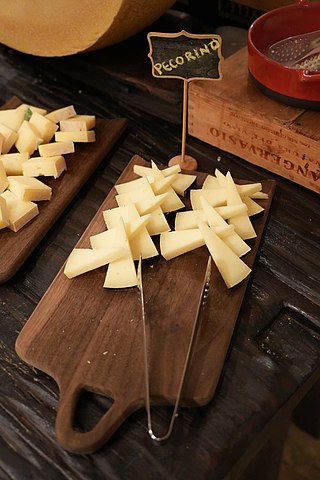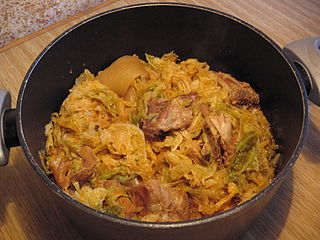Related Research Articles

Mozzarella is a semi-soft non-aged cheese prepared using the pasta filata ('stretched-curd') method with origins from southern Italy.

Pecorino romano is a hard, salty Italian cheese made from sheep's milk, often used for grating over pasta or other dishes. The name pecorino means 'ovine' or 'of sheep' in Italian; the name of the cheese, although protected, is a description rather than a brand: [formaggio] pecorino romano means 'sheep's [cheese] of Rome'.

Pecorino is an Italian hard cheese produced from sheep's milk. The name pecorino derives from pecora, which means 'sheep' in Italian.

Asiago is a cow's milk cheese, first produced in Asiago in Italy, that can assume different textures according to its aging, from smooth for the fresh Asiago to a crumbly texture for the aged cheese. The aged cheese is often grated in salads, soups, pastas, and sauces while the fresh Asiago is sliced to prepare panini or sandwiches; it can also be melted on a variety of dishes and cantaloupe. It is classified as a Swiss-type or Alpine cheese.

Ricotta is an Italian whey cheese made from sheep, cow, goat, or Italian water buffalo milk whey left over from the production of other cheeses. Like other whey cheeses, it is made by coagulating the proteins that remain after the casein has been used to make cheese, notably albumin and globulin.

Cheesemaking is the craft of making cheese. The production of cheese, like many other food preservation processes, allows the nutritional and economic value of a food material, in this case milk, to be preserved in concentrated form. Cheesemaking allows the production of the cheese with diverse flavors and consistencies.

Burrata is an Italian cow's milk cheese made from mozzarella and cream. The outer casing is solid cheese, while the inside contains stracciatella and clotted cream, giving it an unusual, soft texture. It is a speciality of the Puglia region of southern Italy.

Romano cheese is a term used in the United States and Canada for a class of hard, salty cheese suitable primarily for grating similar to pecorino romano, from which the name is derived. In spite of the name, it should not be confused with genuine pecorino romano, which is an Italian product recognized and protected by the laws of the European Union, although United States law allows Romano produced entirely from sheep's milk to be called "pecorino romano".

Pecorino sardo is a firm cheese from Sardinia made from sheep's milk, specifically from the milk of the local Sarda sheep. It was awarded denominazione d'origine (DO) status in 1991 and granted protected designation of origin (PDO) protection in 1996, the year in which this European Union certification scheme was introduced. There are two varieties: Pecorino Sardo Dolce, aged for 20-60 days; and Pecorino Sardo Maturo, which is aged more than 2 months.

There are many different types of cheese, which can be grouped or classified according to criteria such as: length of fermentation, texture, production method, fat content, animal source of the milk, and country or region of origin. These criteria may be used either singly or in combination, with no method used universally. The most common traditional categorization is based on moisture content, which is then further narrowed down by fat content and curing or ripening methods.

Pecorino toscano is a firm-textured ewe's milk cheese originating in the Tuscany region of Italy. Since 1996 it has enjoyed protected designation of origin (PDO) status.

Lombard cuisine is the style of cooking in the Northern Italian region of Lombardy. The historical events of its provinces and of the diversity of its territories resulted in a varied culinary tradition. First courses in Lombard cuisine range from risottos to soups and stuffed pasta, and a large choice of second-course meat or fish dishes, due to the many lakes and rivers of Lombardy.

The traditional cuisine of Abruzzo is eclectic, drawing on pastoral, mountain, and coastal cuisine. Staples of Abruzzo cuisine include bread, pasta, meat, fish, cheese, and wine. The isolation which has characterized the region for centuries has ensured the independence of its culinary tradition from those of nearby regions. Local cuisine was widely appreciated in a 2013 survey among foreign tourists.

Bastardo del Grappa is a traditional cheese produced in the foothills of Monte Grappa massif and in the provinces of Treviso, Belluno, and Vicenza, in Italy. Bastardo del Grappa is a certified prodotto alimentare tradizionale cheese qualifying it as a genuine Italian product.
Red Pecorino is a red Sicilian cheese which was originally developed in Sicily, Italy. In Italian, it is referred to as "Picurinu Rusu". Red Pecorino is made from sheep's milk and Sicilian folate pastes in a technique known as pasta filata which is used in the manufacture of a family of Italian cheeses also known as stretched-curd, pulled-curd, and plastic-curd.
Ricotta di fuscella is a fresh cow's-milk cheese made in the Campania region of Italy. It is recognized as a PAT product.

The cuisine of Basilicata, or Lucanian cuisine, is the cuisine of the Basilicata region of Italy. It is mainly based on the use of pork and sheep meat, legumes, cereals and vegetables, with the addition of aromas such as hot peppers, powdered raw peppers and horseradish. The local gastronomy is, for historical-cultural reasons, typically peasant, based on simple recipes and on the culture of reuse, in particular of meat and bread.
References
- (in Italian) Elenco e descrizione dei prodotti derivati dal latte riconosciuti come tradizionali [ permanent dead link ] dalla Regione siciliana e allegato alla Gazzetta Ufficiale della Regione Siciliana, Palermo, Sabato 6 febbraio 1999, N. 6 Archived 2013-03-16 at the Wayback Machine
- (in Italian) Luigi Cremona e Francesco Soletti, L'Italia dei formaggi: 490 formaggi Dop e tradizionali, 360 produttori con vendita diretta, 517 negozi specializzati, ristoranti ed enoteche con degustazione. Guida Touring, Touring Editore, 2002, ISBN 8836527272, p. 125